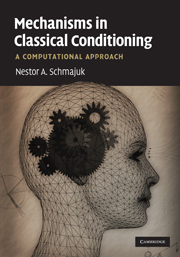Book contents
- Frontmatter
- Contents
- Preface
- Acknowledgments
- Abbreviations
- Part I Introduction
- 1 Classical conditioning: data and theories
- Part II Attentional and associative mechanisms
- Part III Configural mechanisms
- Part IV Attentional, associative, configural and timing mechanisms
- Part V Conclusion: mechanisms of classical conditioning
- References
- Author Index
- Subject Index
1 - Classical conditioning: data and theories
from Part I - Introduction
Published online by Cambridge University Press: 23 May 2010
- Frontmatter
- Contents
- Preface
- Acknowledgments
- Abbreviations
- Part I Introduction
- 1 Classical conditioning: data and theories
- Part II Attentional and associative mechanisms
- Part III Configural mechanisms
- Part IV Attentional, associative, configural and timing mechanisms
- Part V Conclusion: mechanisms of classical conditioning
- References
- Author Index
- Subject Index
Summary
During classical (or Pavlovian) conditioning, human and animal subjects change the magnitude and timing of their conditioned response (CR), as a result of the contingency between the conditioned stimulus (CS) and the unconditioned stimulus (US).
In this chapter we briefly describe results of a number of classical conditioning paradigms that are discussed in detail in different chapters of the book (see Schmajuk, 2008a, 2008b). Then we introduce different types of learning theories. Finally, we present a number of computational models of classical conditioning.
Classical conditioning data
Excitatory conditioning
Acquisition. After a number of CS–US pairings, the CS elicits a conditioned response (CR) that increases in magnitude and frequency.
Partial reinforcement. The US follows the CS only on some trials, and might lead to a lower conditioning asymptote.
Generalization. A CS2 elicits a CR when it shares some characteristics with a CS1 that has been paired with the US.
US- and CS-specific CR. The nature of the CR is determined not only by the US, but also by the CS.
Inhibitory conditioning
Conditioned inhibition. Stimulus CS2 acquires inhibitory conditioning with CS1 reinforced trials interspersed with, or followed by, CS1–CS2 nonreinforced trials.
Extinction of conditioned inhibition. Inhibitory conditioning is extinguished by CS2–US presentations, but not by presentations of CS2 alone.
Differential conditioning. Stimulus CS2 acquires inhibitory conditioning with CS1 reinforced trials interspersed with CS2 nonreinforced trials.
Contingency. A CS becomes inhibitory when the probability that the US will occur in the presence of the CS, p(US/CS), is smaller than the probability that the US will occur in the absence of the CS (p[US/noCS]).
- Type
- Chapter
- Information
- Mechanisms in Classical ConditioningA Computational Approach, pp. 3 - 18Publisher: Cambridge University PressPrint publication year: 2010

